Alannah Fleming, University of Vermont
Before heading to the backcountry everyone learns about the essentials. Consisting of:
-Food
-Map
-Compass
-Medical kit
-Water
-17 eggs
-Ladder
-A giant red bin of research gear
-Pizza for Lily’s birthday
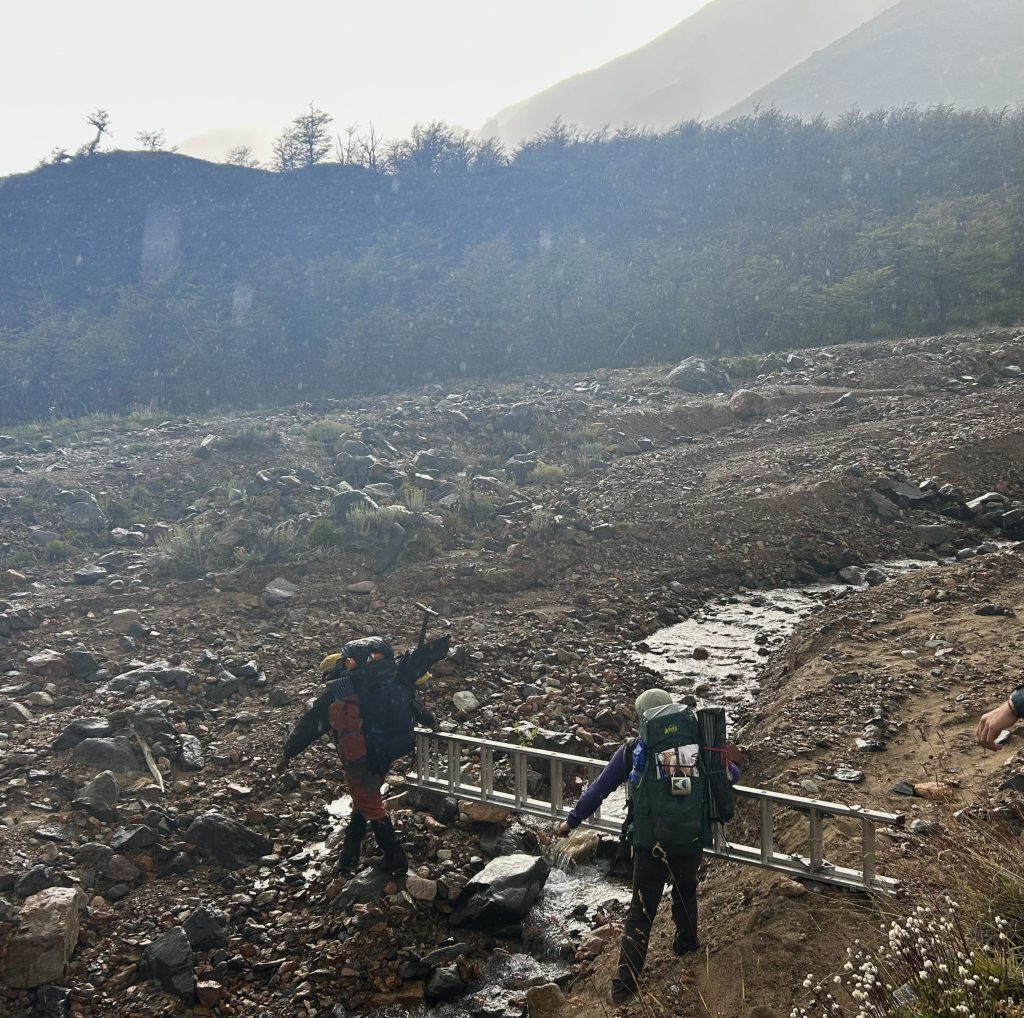
The ladder being hiked out by Jose and Tim 1km while bushwaking. Additionally, some rain was trickling down when this photo was taken. The river pictured was supposed to be where we got our water from, but luckily, we find a water source closer to our campsite!
To be fair, we were only 1km from a road, so I guess it was not the backcountry. However, I soon saw that 1km bushwacking feels a lot longer than 1km on a trail.
On 2/26/2025 we start our 3km walk around Lago Jeinimeni. From here, we grab our stuff (backpacking pack and day pack on the front) and some research equipment. Heading blindly into the woods with only a point on our GAIA map. The path we unfortunately forge consists of fallen trees, caliphate thorns and Acaena spp. spikes (which is a genus of plants that stick their seeds to you). We make the fatal mistake in all of mapping, walking the way the crow flies. This leads us to a cliff in which the campsite was 3 m away, with a steep drop. We ponder continuing down this pass just so we could be at the camp but decide against it due to the large amount of gear and the fact we have 17 eggs with us. In the end, we make it to camp unharmed after 2 hours bush waking. The lesson at this moment was to always download GAIA maps with the topographic lines available as you may find a cliff and turn a 1km walk into a 2km bushwack.
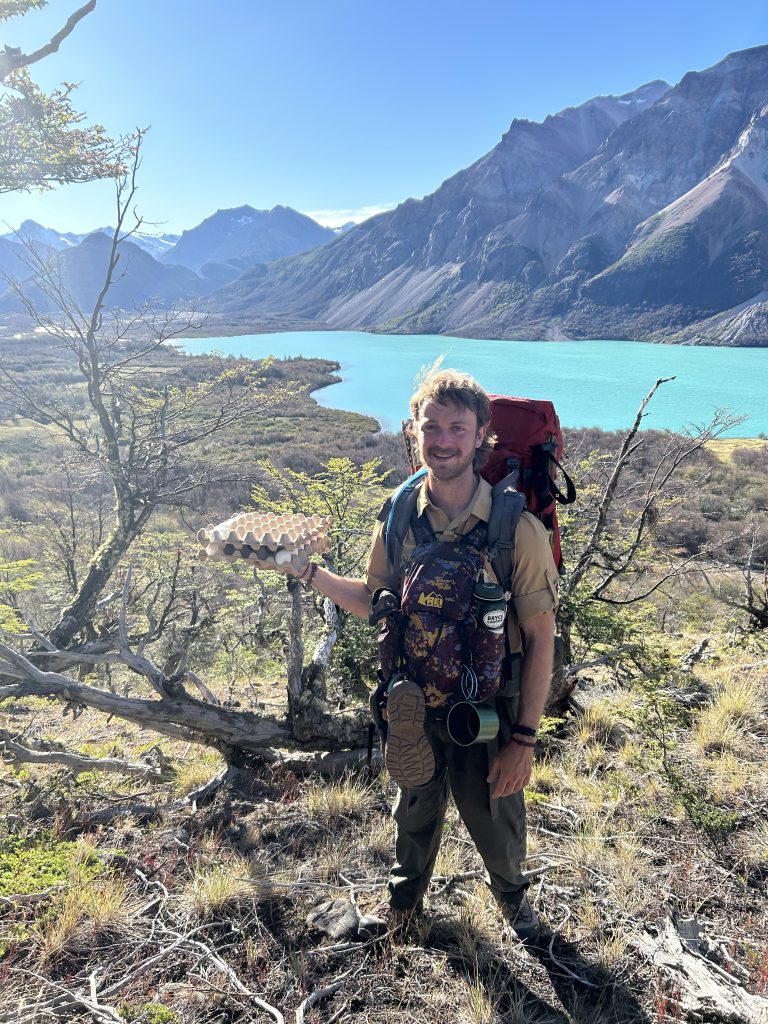
The eggs carried by Oliver making the harsh journey to the campground, only to meet their doom on the last day while trying to make breakfast. The 7-egg breakfast was still well reviewed and an appreciated gift while camping.
The reason for all this work was to study Magellanic woodpeckers (Campephilus magallanicus). This species is endemic to Patagonia and a keystone specie due to their creation of cavity habitat. Their diet consists of insects, dominantly Microplophoru magellanicus. The research is to take observations to estimate the home range size, habitat use and quality of the magellanic woodpecker. There are two main objectives made, the first is to map the territory occupancy and to describe the habitat. There are two different activities each day to reach these objectives: one following the magellanic woodpeckers all day and the second doing a habitat description. Each group being given these separate tasks each day and then switched to the other task. When following the magellanic woodpeckers, notes were taken of foraging behaviors, territorial and social behaviors, nesting and breeding behaviors, movements, and antipredator behaviors. The study takes place in Jeinimeni sector of Patagonia National Park. This area has
the woodpeckers needed forest cover, which is old growth lenga forest. The two nests that are being examined were found in the previous year but have not yet observed. Camera traps are being taken down to watch them, which explains the need for the ladders.
My group’s first day is the habitat survey in the lenga (Nothofagus pumilio) forest. Lenga is a dominant tree species in Chile and the forest being surveyed is entirely lenga. The measurements taken during this include tree height, DBH, and indication of woodpeckers in the area. Not only are there signs of woodpeckers in the area but also signs of caterpillars. The forest is covered in caterpillars, Ormiscodes amphimone, which are native to the area, but have grown in population due to warmer winters not killing them off. They are observed on all portions of the forest levels from baby caliphate to the tallest lenga tree. They eat the leaves off the lenga, which is why they are becoming a problem, as large portions of the forest are defoliated. This brought into question what to call a species that is native to an area but has exploded and started to harm habitats. This portion of Jeinimeni has a decent amount of leaves still on the trees but on higher ground the impacts were seen. A not so fun fact about these caterpillars is that they agitate your skin making it itchy.
The peak of the trip was getting to spend the day watching the woodpeckers 14 hours and 30 minutes to be exact, in the end we walked a total of 6km and 343m of ascent. At 06:30 we headed to the woodpecker nest, which did not come out till 07:05. The first woodpecker to emerge from the cavity is the juvenile which had been named Diva. Diva has dark green/blue eyes, black head and stripes on her back white feathers which is how we identified her as the juvenile. She stayed true to her name as she never stopped chatting once throughout the day and the rest of the time napped.
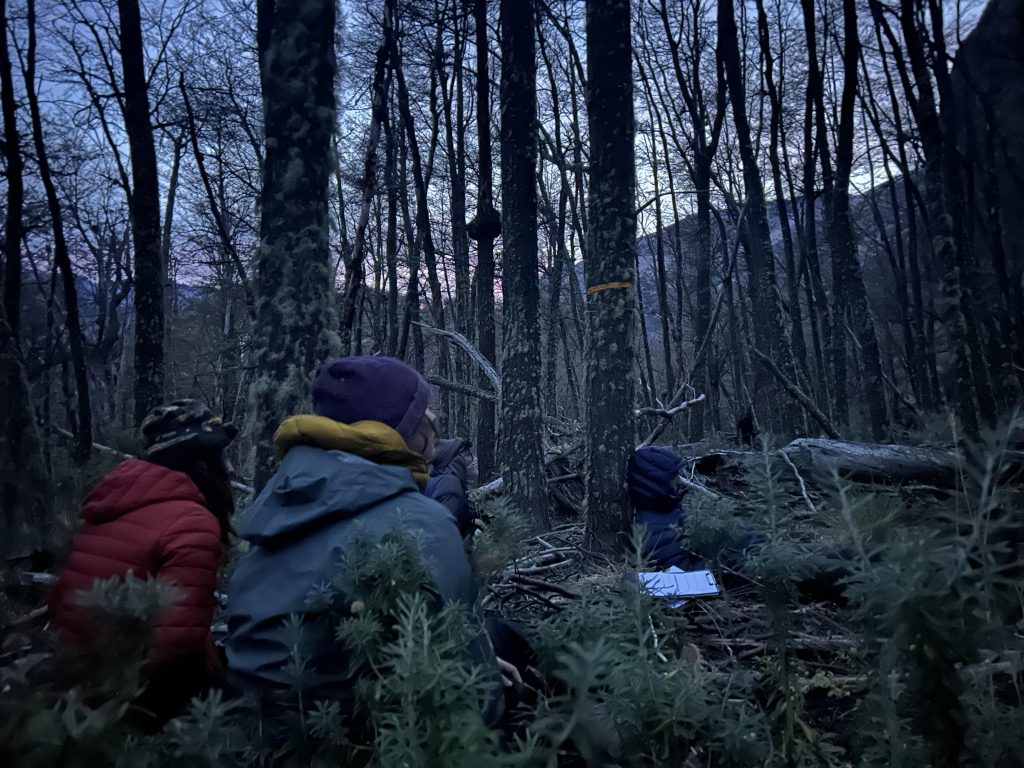
6:50 waiting for the woodpeckers to leave for the day. We started sitting here before the sunrise occurred. After a couple of minutes waiting, I was scared we had already missed them. Luckily they appear soon, after this photo was taken
The rest of the family consists of the parents called Dad and Queen. Queen is the female, completely black and consistently napping (we watched her sleep for 20 minutes). The male is Dad, having a red head and being the easiest to identify. I do not know how I got to the point in my life where I watch a woodpecker family for 14 hours, but I had so much fun doing it. Some notable observations throughout the day is how the woodpeckers glide from tree to tree, their consistent foraging in course woody debris, and that they did not like when we follow them back to their cavity for the night.
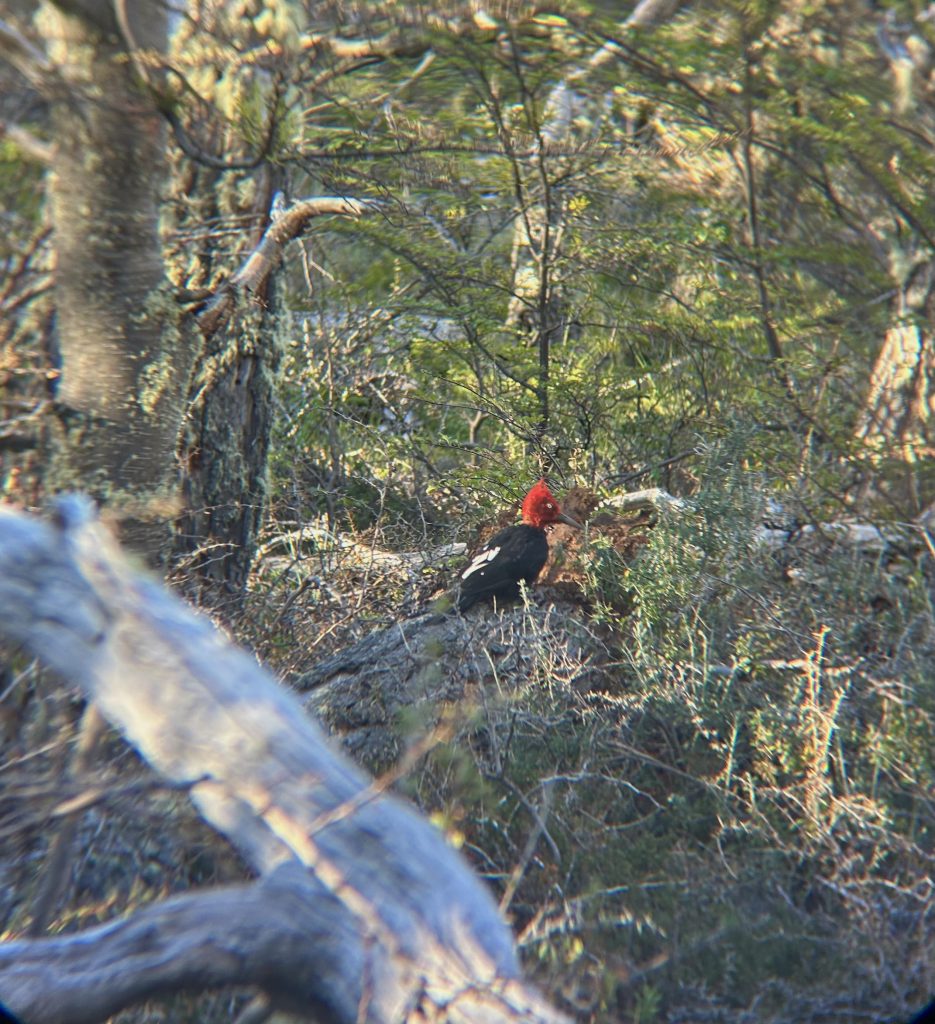
The male woodpecker foraging on coarse woody debris in a riparian area. He was here for 5 minutes which gave me enough time to eat my can of tuna. The photo is taken through a pair of binoculars.
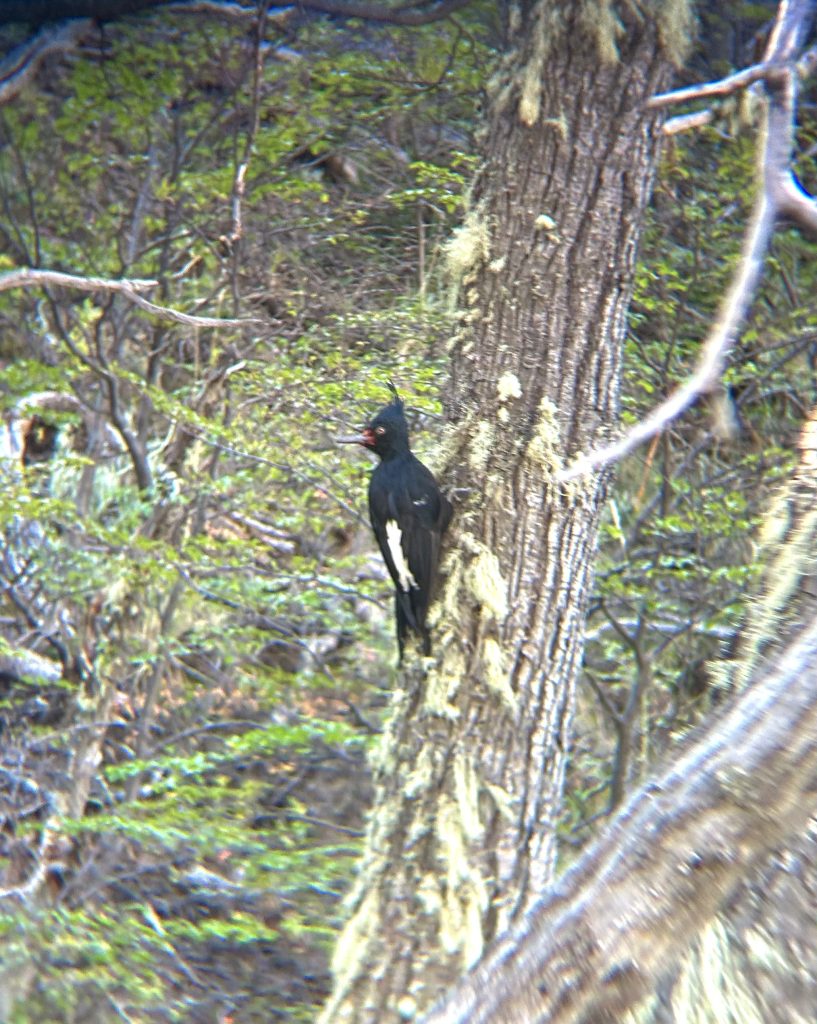
The female woodpecker, showing her white feathers differing from the juvenile. Her head has a curl of feathers that would bob whenever she was foraging, this also differed her from the juvenile. She is seen on a live lenga tree with a good crown, being a mid-age tree. The photo is taken through a pair of binoculars.
The woodpeckers bring us around in circles all day. Sometimes they visit the same sites multiple times. At the start we follow the family up a dry river, which leads to scree and tree line. Here we watch them near the cliff, foraging on small and short lenga. The woodpeckers were easier to observe here, staying on the same tree for minutes at a time. The cliff’s view was stunning as it allowed for a full view of the valley, we were able to see icefields to west and the old campsite we stayed at days earlier to the east. The mountains in front of us are decorated with blues and reds that I never thought a mountain could have. To get down we follow a huemul track and then slide down the rest of the slope.
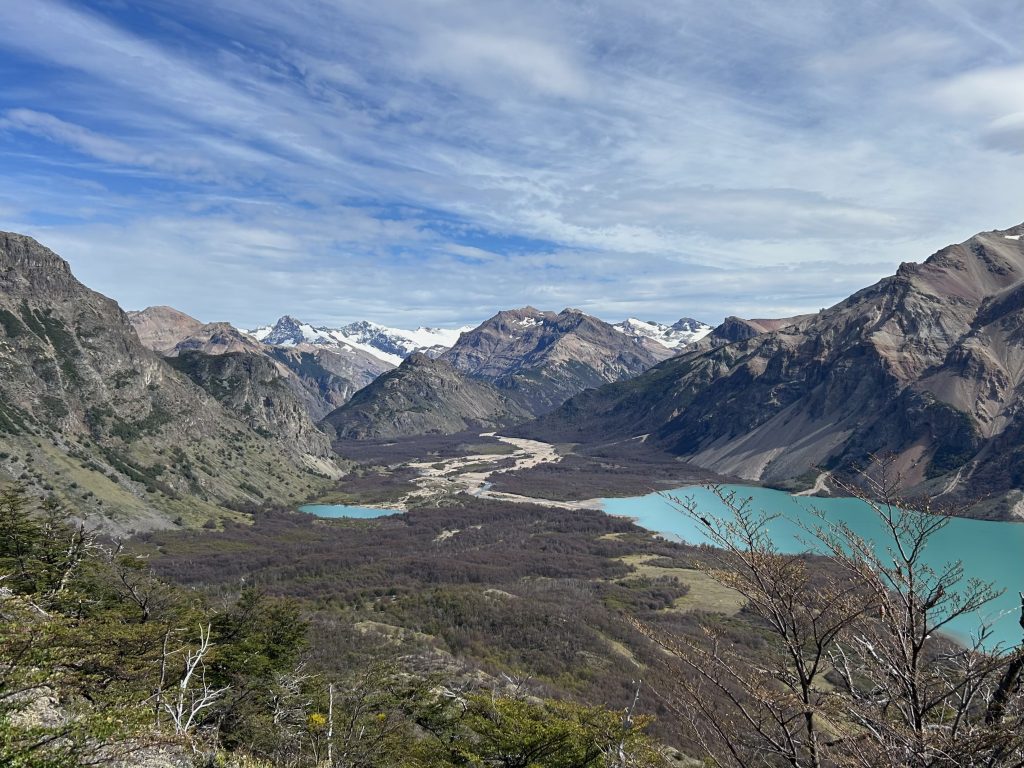
The day started out completely covered in clouds. As we hiked up the clouds parted, allowing us to see this amazing view. Here, we can see Lago Verde which is the smaller lake to the left and the larger one to right is Lago Jeinimeni.
Our day with the woodpeckers ends at 21:15 when the woodpeckers went into a different snag than the one they started the day in. The sun is setting, and it is getting cold, so this was a perfect time to wrap up the day. To end the long day, we have some spaghetti and vegetables in the dark for dinner. If you are ever given the chance to follow a magellanic woodpecker family, it may just be one of the greatest days of your life.
